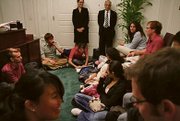Students Mount Campaign For Sweatshop-Free Apparel
In a flashback to the sweatshop protests of the 1980s and 1990s, students once again are hoisting picket signs and staging campus sit-ins to demand administrators get tough with stringent anti-sweatshop policies.
The movement has hit several campuses across the nation, including the University of Southern California in Los Angeles; Stanford University in Palo Alto, Calif.; and the University of Washington in Seattle.
In mid-April, USC students staged a sit-in inside university President Steven B. Sample’s office to urge the university to affiliate with the Worker Rights Consortium, a Washington, D.C.–based nonprofit organization that promotes fair wages for makers of university-logo clothing.
The event was short-lived as administrators threatened to suspend the students.
Shortly afterward, the protesters met with Sample. But student representative Teresa Cheng of the Student Coalition Against Labor Exploitation (SCALE) said the meeting was unproductive. The meeting, she noted, was with a group of lower-level administrators with little clout.
“We will have one more meeting with senior administrators before the school year ends, and we will resume dialogue in the fall,” Cheng said.
However, the protest did raise some awareness. Former state legislator Tom Hayden showed up to provide support, and about 150 students joined a rally after the sit-in.
USC students are among several groups joining in the national campaign to rid campuses of what they perceive as sweatshop-made apparel. In late April, the Stanford Sweat-Free Coalition held a “sew-in” during which students made quilts by sewing together various Stanford shirts. The sew-in was to promote the coalition’s goal of making sure no university apparel is made in sweatshops.
In late May, Stanford students stormed the offices of university President John Hennessey and staged a five-hour sit-in. Eleven members of the coalition were arrested.
Defending themselves, university officials said the school has a number of stringent restrictions in place to make sure all apparel is made legally and ethically.
What they want
Students have been lobbying administrators to adopt the Designated Suppliers Program, a program supported by the Worker Rights Consortium that requires licensees and companies that make university-logo apparel to use sweatshop-free factories.
These factories must demonstrate that they pay their workers fair wages and not inhibit union organization or collective bargaining.
The program requires apparel companies to make at least a threeyear commitment to have their goods made in sweatshop-free factories. In addition, at least 50 percent of a factory’s production must be dedicated to collegiate-sewn goods.
The demand has major financial repercussions. The college-licensed apparel business is part of a $71 billion university apparel industry (according to the Sporting Goods Manufacturing Association) that includes companies such as Nike Inc., Reebok International Ltd., Adidas AG and others battling to outfit entire athletic teams.
Nike, for example, makes uniforms for every single USC athletic team. The teams get the uniforms for free, and the university gets a cash bonus from Nike. In exchange, Nike gets the exclusive license to make all USC-themed athletic apparel sold at sports stores across the country. USC products have been especially hot since the school won two of the past four national football championships.
The university-logo apparel business extends to almost every aspect of the retail channel catering to alumni and sports fans.
That’s why students feel it is so important to affiliate with the Worker Rights Consortium.
So far, more than 170 schools have joined the consortium and 35 have adopted the Designated Suppliers Program.
Last year, the entire University of California system affiliated with the consortium.
A USC spokesperson said the university already monitors factories through the Washington, D.C.–based Fair Labor Association as well as the international Labor Rights Fund. The university code of conduct states that affiliated factories are contractually bound to comply with standards that prohibit forced labor, child labor and harassment and allow freedom of association and collective bargaining. Some USC officials have called the Worker Rights Consortium’s initiatives “radical.”
Zack Knorr, president of Washington, D.C.–based United Students Against Sweatshops, the main organization behind a lot of student protests, said USC’s apparel policies align with its business partners. “The Fair Labor Association [which affiliates with USC] has proved to be mostly ineffective,” Knorr said. “The brands that are being enforced sit on its board of directors, so it’s been a complete failure.”
The USC student protestors maintain the FLA does not make its monitoring reports public and only requires monitoring of up to 5 percent of contracted factories. In comparison, the consortium makes its reports public and requires investigative teams to include local worker representation.
Knorr said adopting the Designated Suppliers Program would probably require companies to contract with smaller factories. In addition, it might call for major restructurings of sourcing networks as well as additional expenses for labor and materials. But, he noted, it would probably cost less than a dollar per garment to adopt the new standards.






















